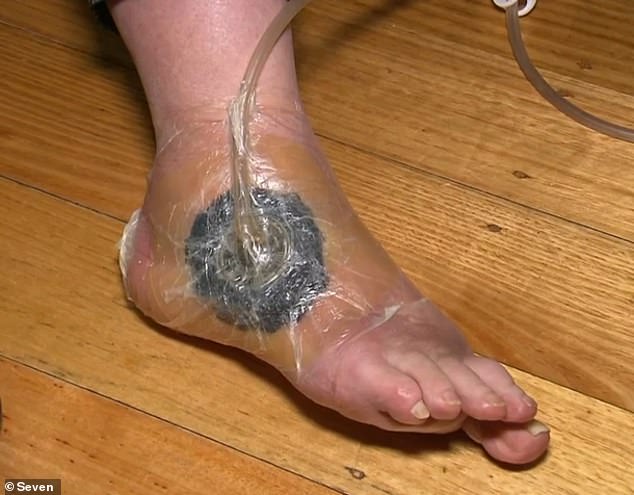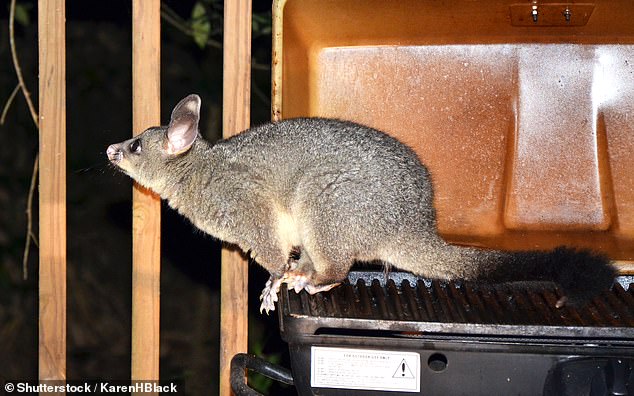Buruli ulcer: Flesh-eating virus spreads across Australia to multiple suburbs
The number of Australians diagnosed with a flesh-eating bacterial skin infection has risen as health authorities warn cases have spread beyond previously known hotspots.
Victorian Health Chief Minister Clare Looker on Tuesday warned that cases of Buruli ulcer in the state were increasing, with 238 identified on October 2 this year compared to 207 at the same time last year.
There were even fewer cases reported in previous years, with 197 in 2021 and 135 in 2020.
Dr Looker, in a health alert, warned the infection was spreading across Victoria and was no longer confined to specific areas on the state’s coast.
Instead, there has been a recent increase in cases linked to multiple suburbs in Geelong including Belmont, Highton, Newtown, Wandana Heights, Grovedale and Marshall.

Melbourne pensioner Fiona Wordie (above) has a Buruli ulcer, a skin infection on the rise in Victoria
There has also been a recent increase in cases linked to Melbourne’s north and inner west, including in the suburbs of Essendon, Moonee Ponds, Brunswick West, Pascoe Vale South and Strathmore, Dr Looker said.
Cases of Buruli ulcer have also been reported in the Mornington Peninsula, Bellarine Peninsula, Phillip Island, Surf Coast and Aireys Inlet, as well as in the Westernport region, the Frankston and Langwarrin regions, the South East Bayside suburbs and in East Gippsland.
Fiona Wordie, 66, lives in Coburg, about 14km north of Melbourne’s CBD.
The suburbs are a high-risk area for Buruli ulcers, but Ms Wordie said she never expected the slight itch on her leg to quickly turn into a two-and-a-half-inch-long sore.
The pensioner’s pain was so severe, her pet cockatoo learned the ‘F word’.
‘That was how painful it was. I don’t normally swear, but I jumped like crazy, it was so bad… It was shocking, just shocking. I’m glad I’m past that stage now,” she told him Sydney Morning Herald.

Ms Wordie said the pain from her ulcer (above) was so bad her pet cockatoo learned the ‘F word’
Ms Wordie spent two weeks in hospital receiving treatment for the ulcer and still undergoes regular debridements to remove dead or infected skin on her legs.
Now, several months later, the ulcer has shrunk to about seven centimeters, but she faces the possibility of more surgeries in the future.
“I’m glad I didn’t lose my leg because that’s what crossed my mind,” she said.
Buruli ulcer was not transmitted from person to person, but a new study found growing evidence that mosquitoes and possums played a role in infecting people in Victoria, Dr Looker said.
The bacteria that cause the ulcer was found in the possum’s droppings, she said.
The study also found that people with diabetes, which weakens the immune system, were more likely to suffer from a severe Buruli ulcer.
In Ms Wordie’s case, her type one diabetes, shingles and a possum living near her home put her at a higher risk of serious infection.
People with Buruli ulcers usually first develop a painless lump or sore, which can be mistaken for an insect bite.
The bumps or sores can slowly develop into a devastating skin ulcer, and it usually took four to five months for an ulcer to develop after someone was infected, Dr Looker said.

A new study found that possum droppings (above) and mosquitoes can spread the bacteria that cause Buruli ulcers
The health chief warned that early diagnosis was essential and said people could prevent infection by avoiding mosquito bites, protecting their homes against mosquitoes and reducing mosquito breeding sites.
They should also cover up when spending time outside, protect cuts and scrapes, quickly wash and dress any fresh scrapes or cuts, and wash their skin after it’s been exposed to dirt or water outside.
Dr Looker urged doctors to quickly test patients for Buruli ulcers if they were in a hot spot and had a non-healing ulcer.
(tagsTranslate) daily mail(s) news(s) Australia(s) Melbourne
